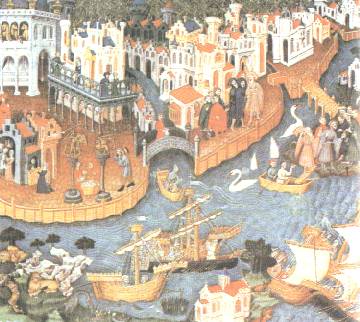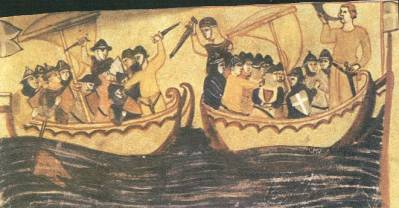In 991 Venice
signed a commercial treaty with the Saracens, initiating the Venetian policy of trading
with the Muslim rather than fighting them. The Crusades and the resulting development of
trade with Asia led to the establishment of Venice as the greatest commercial centre for
trade with the East. The republic profited greatly from the partition of the Byzantine
Empire in 1204 and became politically the strongest European power in the Mediterranean.  In the 13th
and 14th centuries Venice was involved in a series of wars with Genoa, its
chief commercial rival. In the war of 1378-1381, Genoa was compelled to acknowledge
Venetian supremacy. Wars of conquest enabled Venice to acquire neighbouring territories,
and by the late 15th century the city-state was the leading maritime power in
the Christian world. The
beginning of Turkish invasions in the middle of the 15th century marked the
decline of Venetian supremacy. Thereafter, faced with attacks by foreign invaders and
other Italian states, its power waned, and the discovery of a sea route to the Indies
around the Cape of Good Hope by the Portuguese navigator Vasco da Gama in 1497-1498
accelerated the decline. The wealth of Venice depended on the commercial activities it
developed. In the 14th and 15th centuries no other European city
could compare with Venice commercial traffics: it hold the supremacy of the commerce of
the most precious oriental products. Its
merchant ships carried silk from China, carpets from Persia, spices from the Indies,
perfumes from Arabia. Its naval dockyard built a galley a day: a primacy never beaten by
any other maritime city in Europe at those times. The riches produced by its commercial
traffics allowed the Venetian government to build splendid monuments and buildings. After
the fourth Crusade (13th century), Venice had the monopoly of the trade of
oriental products. In order to protect their maritime trades, Venetians organized a
service of coastguard vessels composed of ten ships on patrol, searching the seas sailed
by the Venetian merchant ships. Venice commercial power declined after the discovery of
America, which turned the traffics from the Mediterranean to the Atlantic Ocean. In the 13th
and 14th centuries Venice was involved in a series of wars with Genoa, its
chief commercial rival. In the war of 1378-1381, Genoa was compelled to acknowledge
Venetian supremacy. Wars of conquest enabled Venice to acquire neighbouring territories,
and by the late 15th century the city-state was the leading maritime power in
the Christian world. The
beginning of Turkish invasions in the middle of the 15th century marked the
decline of Venetian supremacy. Thereafter, faced with attacks by foreign invaders and
other Italian states, its power waned, and the discovery of a sea route to the Indies
around the Cape of Good Hope by the Portuguese navigator Vasco da Gama in 1497-1498
accelerated the decline. The wealth of Venice depended on the commercial activities it
developed. In the 14th and 15th centuries no other European city
could compare with Venice commercial traffics: it hold the supremacy of the commerce of
the most precious oriental products. Its
merchant ships carried silk from China, carpets from Persia, spices from the Indies,
perfumes from Arabia. Its naval dockyard built a galley a day: a primacy never beaten by
any other maritime city in Europe at those times. The riches produced by its commercial
traffics allowed the Venetian government to build splendid monuments and buildings. After
the fourth Crusade (13th century), Venice had the monopoly of the trade of
oriental products. In order to protect their maritime trades, Venetians organized a
service of coastguard vessels composed of ten ships on patrol, searching the seas sailed
by the Venetian merchant ships. Venice commercial power declined after the discovery of
America, which turned the traffics from the Mediterranean to the Atlantic Ocean. |




